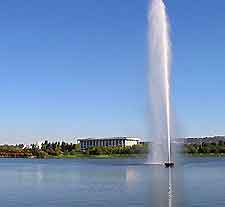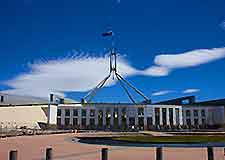Canberra History Facts and Timeline
(Canberra, Australian Capital Territory - ACT, Australia)

Canberra is a relatively young city with just a brief history, being chosen to be the Australian capital as recently as 1908. However, this territory had been inhabited for many years before this, first by Indigenous Australians and then by European settlers.
From 1820 onwards, European families began to settle in what was known as 'Canberry' and they soon started to outnumber the indigenous population. The Church of St. John the Baptist was built in the mid-1840s and remains the oldest building in central Canberra today.
Another building, the lakeside Blundell's Cottage, was built in the late 1850s to house some of the earliest settlers. Today, the building is open to the general public as a museum-type attraction, clearly illustrating how family life was lived in the middle of the 19th century.
Capital Choice
A long-running dispute between
Melbourne and
Sydney began in the late 19th century, with regards to which one should be the Australian capital. The renowned journalist and newspaper proprietor, John Gale, proposed that the Queanbeyan-Canberra area should be chosen over the small town of Dalgety to be the new capital. He put his case forward rather eloquently in a printed leaflet that he distributed to members of parliament. This document was said to be influential in the final decision-making process. Canberra eventually got the nod and a much-publicised design competition was held to find a suitable city plan, with the winner being professional American architect, Walter Burley Griffin.
Naming of the Capital
The most important day in the history of Canberra is 12th March 1913, when it was officially named by the Governor-General's wife, Baroness Denman, in a ceremony that took place on what is now known as Capital Hill. This day is remembered on the second Monday of March each year, when all residents of the Australian Capital Territory celebrate the aptly named 'Canberra Day'.
Growth of the City
Canberra got off to a slow start as two World Wars sandwiching the Great Depression hampered economic development in Australia. Visitors can learn more about Australia's war history by checking out the Australian War Memorial, located at the top of the Anzac Parade.
During this time, the relationship between Canberra's landscape architect and designer, Walter Burley Griffin, and the Australian government, could only be described as 'strained'. In fact, the early city was even said to be something of an 'embarrassment' by the then Prime Minister at the end of WWII.
A Federal Act of Parliament saw the construction of the Australian National University (ANU), which was completed in 1946 and is now home to approximately 13,500 students. In the late 1950s, the National Capital Development Commission (NCDC) was formed, speeding up the city's progress by initiating various projects, such as the building of both the National Library in 1960 and the National Gallery in 1967. Lake Burley Griffin, central to Griffin's design, was finally completed in the early sixties and nowadays, this lake remains a popular place for boating or enjoying a cruise.

The Old Parliament House
The former residence of the Australian government, the Old Parliament House is now home to the Museum of Australian Democracy. This building was the government headquarters for nearly 70 years until the new Parliament House arrived at Capital Hill, opened by Queen Elizabeth II in the year of 1988.
Visitors to Parliament House can join guided tours, or even observe the Prime Minister's 'Question Time' in the House of Representatives. Those visiting will get the chance to see many of the main rooms, such as the Cabinet Room and the office of the Prime Minister, while a photo exhibition gives a fascinating insight into the history of Canberra.
Turbulent Times
Although the city has a reputation as a modern and efficient capital, a small number of events indicate that Canberra's history has not always run smoothly. The year of 1972 saw the Aboriginal Tent Embassy constructed on the grounds of the Old Parliament House. This 'tent' embassy is meant to highlight the plight of indigenous Australians and give them a voice. However, it has become a controversial feature of the Canberra cityscape and has been the site of various vocal protests over the years.
In January of 2003, many parts of Canberra were devastated in bushfires, which sadly led to the death of four people. In total, more than 400 people were injured and nearly 500 homes were destroyed in this natural disaster.
 Canberra is a relatively young city with just a brief history, being chosen to be the Australian capital as recently as 1908. However, this territory had been inhabited for many years before this, first by Indigenous Australians and then by European settlers.
Canberra is a relatively young city with just a brief history, being chosen to be the Australian capital as recently as 1908. However, this territory had been inhabited for many years before this, first by Indigenous Australians and then by European settlers.